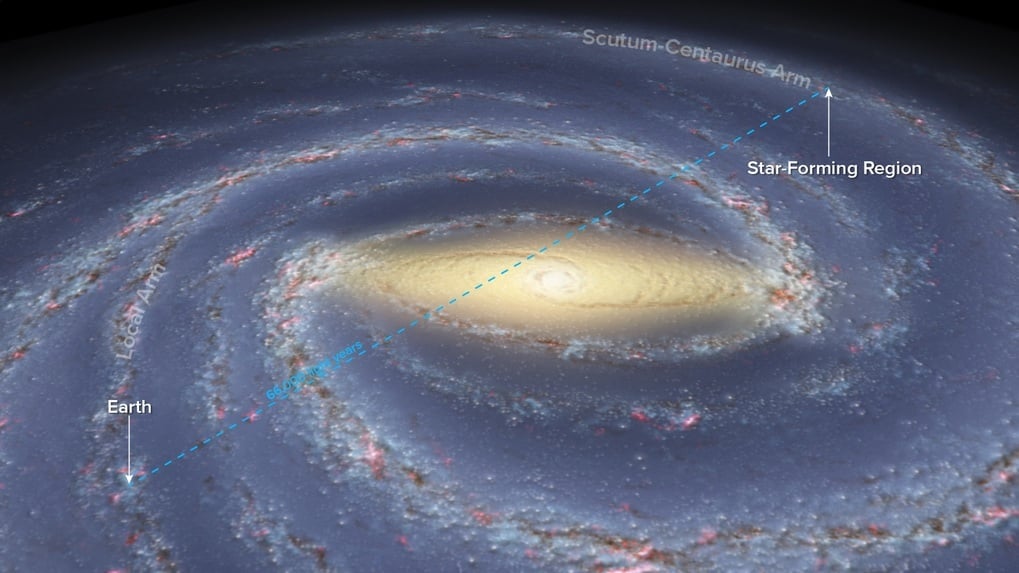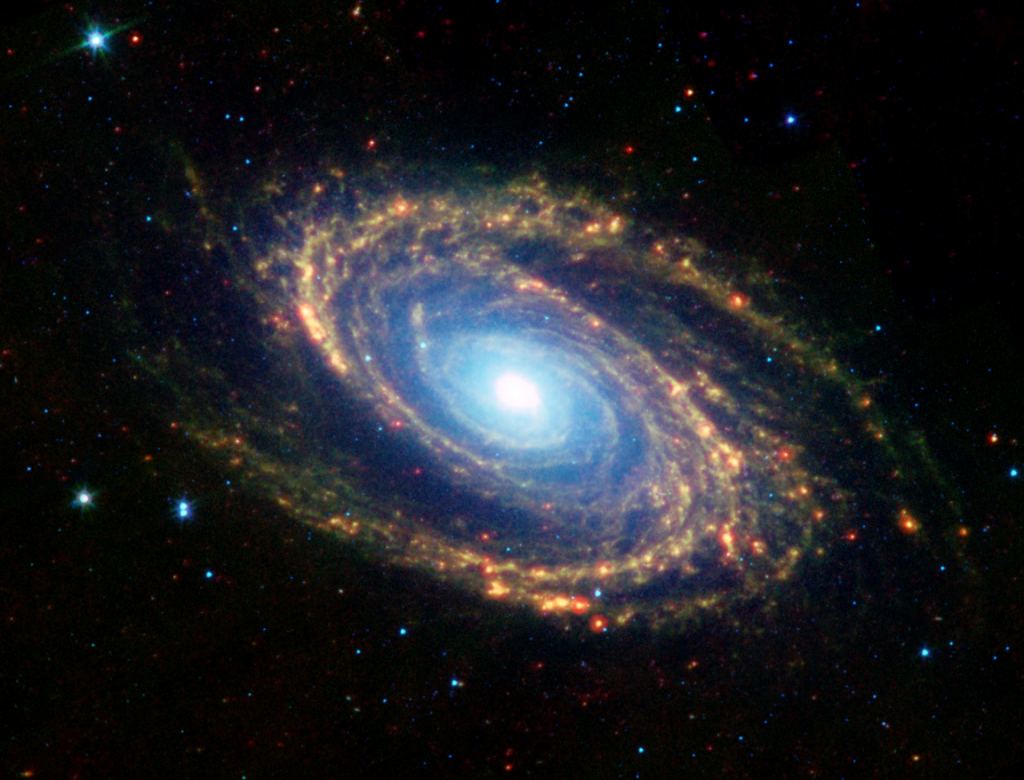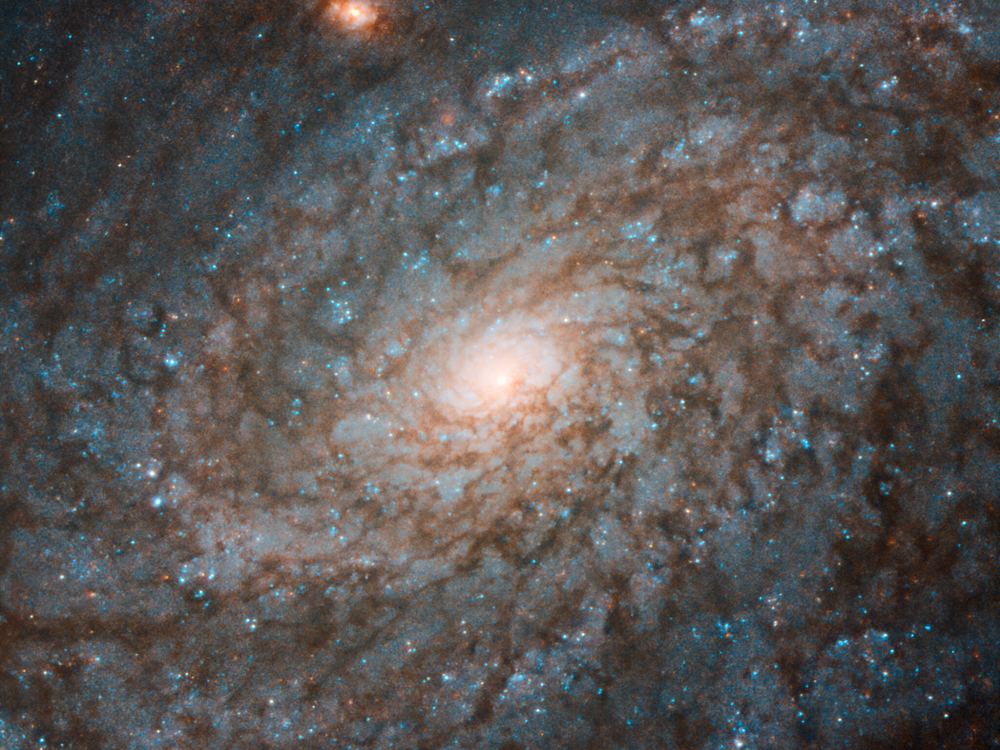Beginning in 1610, when famed Renaissance polymath Galileo Galilei observed the night sky using a telescope of his own manufacture, astronomers gradually realized that our Solar System is part of a vast collection of stars known today as the Milky Way Galaxy. By the 20th century, astronomers had a good idea of its size and structure, which consisted of a central "bulge" surrounded by an extended disk with spiral arms. Despite all we've learned, determining the true morphology of the Milky Way has remained a challenge for astronomers.
Since we, the observers, are embedded in the Milky Way's disk, we cannot see through the center and observe what's on the other side. Using various methods, though, astronomers are getting closer to recreating what a "birds-eye" view of the galaxy would look like. For instance, a team of researchers from the Chinese Academy of Sciences (CAS) used the precise locations of very young objects in our galaxy (for the first time) to measure the morphology of the Milky Way. This revealed a multiple-arm morphology consisting of two symmetrical arms in the inner region and many irregular ones in the outer region.
The team was led by Xu Ye, a radio astronomer with the Purple Mountain Observatory in Nanjing and the School of Astronomy and Space Science (SASS) at the University of Science and Technology of China (UCAS). He was joined by multiple astronomers and astrophysicists from the Purple Mountain Observatory, the SASS/UCAS, and the National Astronomical Observatories of China in Beijing. The paper that describes their findings, titled " What Does the Milky Way Look Like? " recently appeared in *The Astrophysical Journal*.
What we know about the Milky Way's structure is largely thanks to the pioneering work of William W. Morgan, who was instrumental in the classification of stars and galaxies. During the 1950s, he and his colleagues used spectroscopic parallax measurements of high-mass stars to map out the Milky Way and discovered three short spiral-arm segments. The large-scale structure was mapped soon after based on the distances of neutral hydrogen (HI) clouds (derived from kinematic methods), which revealed that these spiral arms extended almost across the entire Galactic disk.
However, the distances of neutral hydrogen clouds were found to have large uncertainties due to noncircular (peculiar) motions, making the results in these early studies unreliable. Photometric methods are much more accurate than kinematic methods. However, they can only be used to determine objects at distances up to around 2 kiloparsecs (~6500 light years) - roughly 6.5% of the Milky Way's diameter. For this reason, kinematic methods are still widely used to study the entire Milky Way. This led to modern maps that included four major arms: the Sagitarrius, Orion, Perseus, and Cygnus Arms (closest to farthest from Galactic Center).
Despite improvements in kinematic and optical methods, determining the structure of the Milky Way remains a significant challenge for astronomers. As such, the debate continues when it comes to basic issues like the number of arms, the existence of some spiral arms, and the overall size of the Milky Way (estimates are subject to an uncertainty of ± 3,590 light-years). As Ye told Universe Today via email, the best way to settle this debate is to use young stars as "spiral tracers," which will yield accurate distance measurements:
"Directly mapping the spiral structure of the Milky Way has proven to be a challenging enterprise. Star-forming regions and young stars can trace the spiral arms of galaxies. Knowing the distances to star-forming regions or young stars, one can locate them in three dimensions and construct a 'plan view' - a view from above the disk - of the Milky Way. Astronomers can make sense of the Milky Way only if they know the distances to young objects, so methods of distance measurement are important."
For galaxies like the Milky Way, spiral arms consist of two main components: a spiral pattern indicated by the distribution of the older stellar population; and regions of diffuse or dense interstellar gas and young objects. These include high-mass star-forming regions (HMSFRs), massive O–B stars, regions of interstellar hydrogen gas (Hii), young open clusters (YOCs), and others. Since the turn of the century, astronomers have made substantial progress in measuring the structure of the Milky Way using young objects.
Much of this is due to the emergence of Very-Long Baseline Interferometry (VLBI), which has allowed for precise distance measurements (via trigonometric parallax) for star-forming regions throughout the galaxy. The ESA's *Gaia Observatory* has also provided precise data on the proper motion and distance of many young stars, helping astronomers determine the galaxy's spiral structure in the vicinity of the Solar System. Combining more accurate distance and velocity measurements led Yu and his colleagues to some interesting conclusions. As he explained:
"Traditionally, one can construct a simple model of the rotation speed of stars and star-forming gas as a function of distance from the center of the Milky Way. Then, if one measures the line-of-sight component of the velocity of a star or gas, one can determine its distance by matching the observation with the model prediction (that is, a kinematic distance)." "Using the precise locations of very young objects provided by the BeSSeL and VERA projects (VLBI) and by ESO's Gaia satellite, for the first time, we reveal that our galaxy has a multiple-arm morphology that consists of two-arm symmetry in the inner parts and that extends to the outer parts, where there are several long and irregular arms."
According to the team's results, the structure of the Milky Way consists of the Perseus and Norma arms in the inner region and the Centaurus, Sagittarius, Carina, Outer, and Local Arm in the outer region. These findings are supported by what has been observed with external spiral galaxies, which fall into three largely distinct categories based on their morphology. This includes grand-design galaxies, multiple-arm, and flocculent galaxies, which are differentiated by the prominence or subtlety of their spiral-arm structure.
Whereas grand-design galaxies like M81 (see above) have well-defined spiral arms, multi-arm and flocculent galaxies like NGC 4237 (shown above) are more patchy and have discontinuous spirals arms, lending them a more "fluffy" appearance. In addition, almost no external galaxies have been found where four spiral arms were observed extending from the centers to their outer regions. As Yu summarized:
"In our work, based on high-precision data of various young objects, we found that the Milky Way is a multiple-arm galaxy. This is the key difference between our map and existing maps, which provides a possible alternative for future studies of the Galactic structure. Besides, 83% of the multiple-arm external galaxies clearly present two inner arms. Therefore, in this case, the morphology of our Galaxy is similar to those of most multiple-arm galaxies in the universe. In short, our findings hint that the spiral structure of the Milky Way may not be as unique as previously thought.
These findings could have drastic implications for our understanding of the Milky Way. It is also comforting to know that in terms of morphology, the team's results show that our galaxy is not an outlier but an example of a statistically significant astronomical object.
Further Reading: arXiv
 Universe Today
Universe Today



